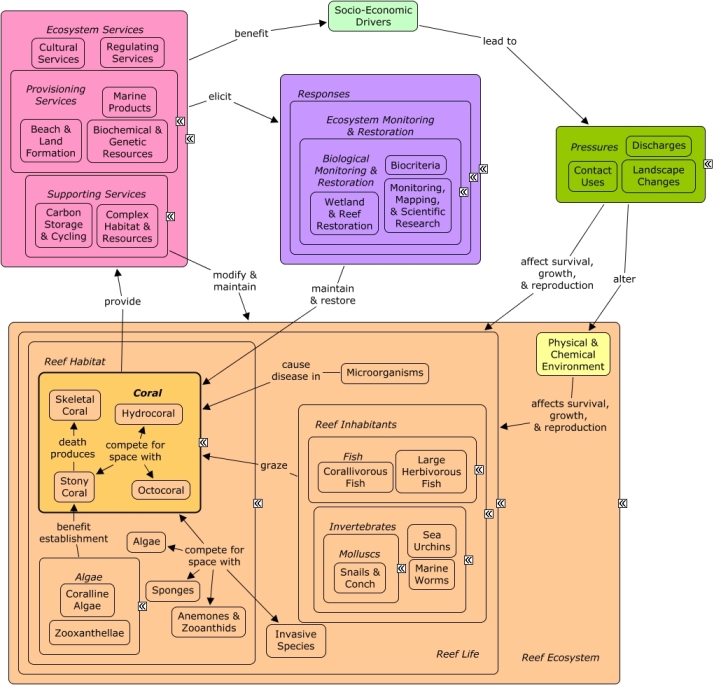ReefLink Database

Skeletal Coral
Skeletal coral is the calcium carbonate structure that remains after the coral animals have died.
CMap

CMap Description
Coral provide the basis for all reef ecosystem services and thus the well-being and welfare supplied by the coral reef ecosystem. Stony coral produces large quantities of calcium carbonate skeleton that may persist in the marine environment long after the colony has died. The resulting carbon storage & cycling builds the physical structure of the reef and results in the other supporting services of complex habitat & resources and reef structural strength, and ultimately results in sand & land production. Physical damage and ocean acidification can affect the strength and dissolution rates of coral skeletons, and thus the persistence of habitat and wave attenuation that they provide. Monitoring and research can be implemented to better understand the role of coral skeletons in the reef ecosystem.Citations
More than 50 citations. Click here to load.
| Citation | Year | Study Location | Study Type | Database Topics |
|---|
Management Options
| Management Option | Description | Sources | Database Topics |
|---|---|---|---|
| Monitor & Research: Biological Status and Trends Monitoring | This activity produces long-term comprehensive information on sanctuary-wide status and trends of biological resources. Data that could be collected on coral reef communities includes but is not limited to species abundance and density, biodiversity, benthic cover, coral condition, growth, recruitment, predation, and grazing. Mangroves and seagrasses should also be monitored. With adequate baseline data, changes in community structure and biocriteria can be identified and restoration or protection efforts can be taken. | NOAA Marine Sanctuary Program. 2007. Florida Keys National Marine Sanctuary revised management plan. National Ocean Service, Key West, FL. |
Algae; Anemones & Zooanthids; Apex Fish Predators; Aquaculture; Aquarium Stock; Biochemical & Genetic Resources; Biocriteria; Biological Harvest; Biological Monitoring & Restoration; Biological Monitoring, Mapping, & Scientific Research; Bivalves; Calcareous Macroalgae; Contact Uses; Coral; Coralline Algae; Cyanobacteria; Decision Support; Echinoderms; Ecosystem Monitoring & Restoration; Finfish & Shellfish Stock; Fish; Fishing Sector; Food & Energy Policies; Hydrocoral; Invasive Species; Invertebrates; Large Herbivorous Fish; Lobster, Crab, & Shrimp; Mangroves; Marine Birds; Marine Products; Marine Vertebrates; Marine Worms; Microorganisms; Molluscs; Octocoral; Octopus & Squid; Ornamental Jewelry & Art; Pathogens; Pharmaceuticals & Cosmetics Sources; Physical Damage; Primary Production; Provisioning Services; Resource Use Management; Sea Turtles; Sea Urchins; Seagrasses; Seastars; Skeletal Coral; Small Herbivorous Fish; Snails & Conch; Sponges; Stony Coral; Tunicates; Wetlands; Whales & Dolphins |
| Regulatory Review and Development: Evaluate Coral Touching Regulations | Currently touching, removing, damaging, distributing, and injuring any living or dead coral or coral formation is prohibited in Sanctuary Preservation Areas and Ecological Reserves. An investigation will be conducted to consider extending this prohibition to high-use, sensitive and vulnerable areas. | NOAA Marine Sanctuary Program. 2007. Florida Keys National Marine Sanctuary revised management plan. National Ocean Service, Key West, FL. |
Beaches & Nature Parks; Contact Uses; Coral; Decision Support; Dredging Regulations; Physical Damage; Skeletal Coral; Stony Coral; Tourism & Recreation; Tourism & Recreation Policies; Trampling |
| Restoration: Restore Reef Habitat and Salvage Benthic Inhabitants Injured by Physical Damage | This management approach involves salvaging, maintenance, and re-stabilization or injured resources by management staff and private contractors in order to rescue and provide first aid following physical damage such as vessel groundings. This can be achieved using Reef Medics and other volunteer programs because these groups have experience with vessel navigation and operation, snorkeling, and SCUBA diving. Also, it allows for researchers to collect living coral material when relocation of such organisms is not possible. Salvage and re-stabilization is not limited to the living coral; octocorals, seagrasses, and the non-living framework may all be damaged of destabilized from groundings or other physical impacts. In addition to the habitat's structural integrity, it is important to re-establish aesthetics and ecological functionality. Funds from mitigation and case settlements should be used for this work, as long term costs of restoration and monitoring can be extensive. | NOAA Marine Sanctuary Program. 2007. Florida Keys National Marine Sanctuary revised management plan. National Ocean Service, Key West, FL. Collier, C., Dodge, R., Gilliiam, Gracie, K., Gregg, L., Jaap, W., Mastry, M., and Poulos, N. 2007. Rapid Response and Restoration for coral reef injuries in the southeest Florida. Southeast Florida Coral Reef Initiative. |
Anchoring & Vessel Grounding; Biological Monitoring & Restoration; Biological Monitoring, Mapping, & Scientific Research; Boating Activities; Coastal Engineering; Collaboration & Partnering; Contact Uses; Coral; Cultural Policies; Cultural Services; Culture; Dredging Regulations; Dredging, Draining, & Filling; Ecosystem Monitoring & Restoration; Educational & Research Opportunities; Octocoral; Physical Damage; Reef Habitat; Reef Life; Resource Use Management; Seagrasses; Security & Public Administration Policies; Skeletal Coral; Stony Coral; Trawling & Fishing Gear Damage; Water Transportation; Wetland & Reef Restoration; Wetlands |
| Restoration: Removal of Invasive Algae | Benthic organisms on reefs maintain a delicate balance competing for space. In many areas, the competition between coral and algae has fallen out of balance due to confounding factors. Factors such as decreased herbivorous fish and invertebrates, and invasive algae species have allowed faster growing algae to take over many reefs, often growing into smothering mats that cover and kill coral. In Hawaii, there has been some success physically removing invasive algae such as Kappaphycus using underwater vacuums extended down from barges or volunteer events in shallower areas. | The Nature Conservancy. 2010.Two Million Pounds of Invasive Algae Removed From Maunalua Bay. (not cited) |
Algae; Aquaculture; Biological Addition; Biological Harvest; Biological Monitoring & Restoration; Biological Monitoring, Mapping, & Scientific Research; Calcareous Macroalgae; Collaboration & Partnering; Coral; Coralline Algae; Decision Support; Ecosystem Monitoring & Restoration; Escape & Release of Non-natives; Fishing & Harvesting Management; Fishing Sector; Fleshy Macroalgae; Hydrocoral; Invasive Species; Large Herbivorous Fish; Octocoral; Reef Habitat; Skeletal Coral; Small Herbivorous Fish; Stony Coral; Turf Algae; Wetland & Reef Restoration; Zooxanthellae |
Laws
| Legal Citation | Purpose of Law | Management Organization | Database Topics |
|---|---|---|---|
| Endangered and Threatened Species; Critical Habitat for Threatened Elkhorn and Staghorn Corals, 73 Federal Register § 6895 (2008). | To make it unlawful, to import or export the species into or from the US, to take the species within the US or territorial seas of the US, to take the species upon the high seas, to possess, sell, deliver, carry, transport, or ship by any means whatsoever the species taken in violation, to deliver, receive, carry, transport, or ship in interstate or foreign commerce, by any means whatsoever and in the course of a commercial activity the species, to sell or offer for sale in interstate or foreign commerce the species, to violate any regulation pertaining to the species. Application to Coral Reefs:The deignation of Acropa palmeta and Acropa cervicornis as threathened species will allow the species advantages in recovery. The designation protects the reef habitat because the species must have the reef to reproduce and grow. Legislative Actions:Section 11 of the ESA provides civil and criminal penalties for a violation of the ESA. Comments: |
NOAA Jurisdiction: US Coral Reefs; US Territorial Waters; US Virgin Islands; Puerto Rico |
Accidental & Illegal Harvest; Collaboration & Partnering; Environmental Education & Outreach; Fishing & Harvesting Management; Invertebrate Harvest; Recreational Opportunities; Skeletal Coral; Tourism & Recreation; Tourism & Recreation Policies |
